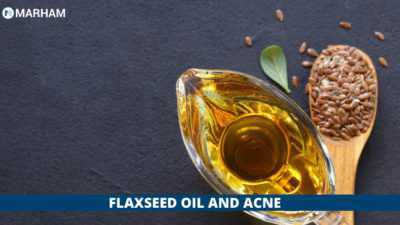Flaxseed oil for acne is really famous and it can help some people get rid of acne, but it won’t work for everyone. Flax oil has been shown to reduce inflammation, and popular ideas suggest that it helps with hormonal disorders and counteracts the effects of stress on the body. There isn’t much clinical study on flaxseed’s health advantages, but scientists are looking into it. HERE, we are letting you know about some of the facts about flaxseed oil and acne. TO KNOW IN MORE DETAIL CONTACT A DERMATOLOGIST; CLICK HERE TO BOOK AN APPOINTMENT.
Significance
Acne sufferers who use flaxseed oil report fewer breakouts, improved skin tone, reduced redness and puffiness, and overall healthier skin. Flaxseed is advocated for its anti-acne properties, as well as for supporting prostate health, cardiovascular health, hair loss prevention, breast health promotion, and relief of postmenopausal symptoms. However, according to nationally known physician and medical writer Ray Sahelian, MD, of Los Angeles, Calif., author of “Mind Boosters” and “The Stevia Cookbook,” there is no clinical data to back up these claims. Acne sufferers who use flaxseed oil report fewer breakouts, improved skin tone, reduced redness and puffiness, and overall healthier skin.


Potential
According to research omega 3 fatty acids in flaxseed have been shown to help reduce inflammation and may also minimise the effects of stress on the body. According to the Acne Treatments Guide website, acne is mostly an inflammatory response by the body, thus addressing this issue will assist. Stress can also induce or encourage inflammation. According to the Herb Wisdom website, omega-3 fatty acids also help to thin the greasy sebum that can block pores. BOOK AN APPOINTMENT TO KNOW THE MORE DETAILS FROM A DERMATOLOGIST BY YOURSELF.
Benefits
According to the University of Maryland Medical Center, people in the United States often require additional omega-3 fatty acids, such as those found in flaxseed, in their diets. Many people ingest too much omega-6 fatty acid, which is found in corn and safflower oils. According to the Helpful Oil Planet website, while omega-6s are healthy in some respects, they, like the bad saturated and hydrogenated fats widely ingested in the United States, promote inflammation in the body. According to the University of Maryland Medical Center, an improper balance of omega-6 to omega-3 essential fatty acids increases to inflammation, whereas a proper balance improves health.


A person has to consume two to four times more omega-6 fatty acids than omega-3 fatty acids to sustain a healthy diet. The average American, on the other hand, consumes 14 to 25 times more omega-6s than omega-3s. According to the University of Maryland Medical Center, people in the United States need more omega-3 fatty acids in their diets, such as those found in flaxseed. According to the Healthy Oil Planet website, while omega-6s are beneficial in some respects, they, like the bad saturated and hydrogenated fats widely ingested in the United States, increase inflammation in the body.
Lignans
Lignans are abundant in flaxseed, making it one of the best sources. Lignans are a type of substance present in plant cell walls. According to the Herb Wisdom website, lignans appear to have a good impact on hormone-related issues, which can occasionally lead to acne. Because lignans are easily absorbed by the body, they may be particularly beneficial. While clinical studies on the specific lignan contained in flaxseed are few, the Natural and Nutritional Products Industry Center notes that researchers are undertaking clinical trials to investigate the lignan’s potential advantages. Secoisolariciresinol diglycoside is the major lignan found in flaxseed.
Considerations
Other foods that include the omega-3 fatty acid alpha linolenic acid (ALA), which is found in flaxseed, include soybeans, canola oil, pumpkin seeds, walnuts, and perilla seed oil. People can consume one of three forms of omega-3 fatty acids: ALA, EPA, and DHA. Eicosapentaenoic acid (EPA) and docosahexaenoic acid (DHA) are the other two (DHA). The body actually converts ALA to EPA and DHA. According to the University of Maryland Medical Center, flaxseed oil will not be useful for treating acne for everyone because not everyone’s body can convert ALA. Most persons with diabetes or schizophrenia, for example, lack this skill. Fish oil is high in EPA and DHA. TO KNOW MORE TALK TO AN EXPERT.


Consult with the Best Dermatologist of Marham
Book an appointment now to answer all your queries. You can book an appointment with the Best Dermatologists in Lahore through Marham by calling at Marham helpline: 0311-1222398 or by online booking facility through the website or Marham mobile app.
Can’t Find The App?
| Android | IOS |
|---|---|
  |
  |
FAQ’S
Is flaxseed oil good for acne?
Omega-3 fatty acids, which are crucial for health, appear to be one of the key benefits of taking flaxseed oil for acne. Omega-3 fatty acids have been shown in certain studies to help reduce inflammation, which is a role in some kinds of acne.
How do you use flaxseed for acne?
During the luteal phase, you should ingest one tablespoon each of flax- and pumpkin seeds, according to standard seed cycling practice (beginning on day one of your period). During the follicular period, switch to sunflower and sesame seeds (usually, day 15)
Does flaxseed improve skin?
Flaxseeds are really beneficial to our body as well as your skin. They include lignans and antioxidants, which assist to tighten the skin and prevent sagging. They also include fatty acids, which nourish, hydrate, and moisturise your skin.
Can I apply flaxseed gel overnight?
Yes, leaving flaxseed gel in your hair overnight is safe.

